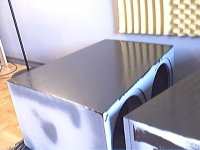For the love of god how many times do i have to do this ? Look at it. Is not even. It seemed that way with 4 coats of primer... now i start throwing black on there and BAM there are lines. Should i be doing this with a spray can and NOT a roller brush combo ?
Attachments
cowanrg said:im lacquering my wood faceplate for my preamp, and after 4 cans of lacquer and 30+ coats later, its ALMOST the way i want it. it takes time if you want it perfect. ive been spending a month on a piece thats 16.5" x 4.5".
GAHHHHHHHHH

 ! ! !
! ! !Bill: No one listened to you because you haven't given any suggestions yet. Just complaints.
It may be old hat to you, but some folks are hearing it for the first time. You're not explaining it over and over to the same person. So why not be a sport and give Mike the benefit of your experience?
It may be old hat to you, but some folks are hearing it for the first time. You're not explaining it over and over to the same person. So why not be a sport and give Mike the benefit of your experience?
I got it after i posted, what he meant i mean. thats why i cracked a joke. I am not a photographer so i dont 'think' like one. I apologize for having a patterned object in the background. I will make it a point to set the light proper if i bother to ask how to get a nice clear coat on a box again. But i probably wont as i figure things out pretty quick as long as thinking isnt involved.
SY said:Bill: So why not be a sport and give Mike the benefit of your experience?
Right.
Mike:
When you want to illustrate the finish on an item you need to illuminate and photograph the item at angles which allow the camera to see the defects in the finish. This is facilitated by not allowing any object which may reduce clarity to be reflected from the surface and into the camera lens. If you want comments or suggestions on how to reduce or eliminate the flaws, all those in a position to assist you must be able to see your results. Of course this requires more effort than just picking up the camera and shooting. We dearly want to help but you must put forth some effort as well.
Is that better?
cowanrg said:im wondering who the over "vote" is for the wrong way...
oh well, bill's a cool guy and knows his stuff, he just has a serious case of sand in his vagina. one of these days, he will get the sand out and be nice once again
I douche daily - with Mirror Pond.
BassAwdyO said:
mispellings
. . . . . but I'm impressed
I'm not.
Bill Fitzpatrick said:
I douche daily - with Mirror Pond.
i was hoping you would take that comment lightly and for what it was worth (absolutely nothing).
sometimes you have to realize that 90% of the people on this site are beginners in some fashion. they will make mistakes, even stupid basic ones. i get mad every so often when i look over in the world of diy projectors and see some guy saying "hey, what about LED's!". been there done that back in '02. didnt work back then, doesnt work now.
however, when you start a project sometimes its hard to get your head around all the little details that you learn along the way in the big learning process. im learning DIY CNC machine building. it took about 6 months to just get the idea of what is generally involved in making one. i could make a flow chart of whats needed, but the actual specifics are mysteries still.
all in all, just give a dude a break. no one forces you to respond to "stupid" questions, comments, or ideas.
I'm not.
Neither was I really..... but I thought I might say that to be nice
Back to Mike's original question: Did you sand between each coat of primer? You need to put down many thin -to moderate thickness coats (the 4 you used is a good number) let each dry and sand between them with increasingly fine sandpaper. You also need to spray the finish if you want really smooth surface.
For example: I'm finishing part of my line arrays with black Rustoleum spray lacquer (available at every Wall Mart and Home Depot). I start by first sanding the MDF with 120 through 180 grit sandpaper with a random orbital sander. I then spray a coat of primer (Rustoleum sandable primer for instance) and then sand it with 180 through 320 grit random orbital sander. You will sand through parts of the primer. That's why you need to put down multiple coats. I continue this until the primer looks and feels smooth.
I then start spraying lacquer. I'll spray 2-3 thin coats without sanding just to build up a base thickness. Don't even try to get a shiny finish at this point. I then start sanding the lacquer with 240 grit wet sandpaper using a sanding block. The sanding block is very important. You will never get a real smooth finish using your hand. after 240 I use 400 grit wet/dry. Keep spraying/sanding until sanding gives you a smooth sanded surface with no shiny spots (i.e. low spots the sandpaper did not touch). You can then give it a coat of clear lacquer, sanded with 400 grit and maybe even 1000 grit wet sandpaper. Then give it one more clear coat and your done. Give the paint time to dry. If you put too many coats of lacquer without giving each time to really dry (say 12 hours or more) you will end up with a thick soft gooey mess that will never completely dry or worse it will crack. Ask me how I know.
It's not easy but not impossible. You can take shortcuts on these steps depending on how many imperfections you can tolerate.
For example: I'm finishing part of my line arrays with black Rustoleum spray lacquer (available at every Wall Mart and Home Depot). I start by first sanding the MDF with 120 through 180 grit sandpaper with a random orbital sander. I then spray a coat of primer (Rustoleum sandable primer for instance) and then sand it with 180 through 320 grit random orbital sander. You will sand through parts of the primer. That's why you need to put down multiple coats. I continue this until the primer looks and feels smooth.
I then start spraying lacquer. I'll spray 2-3 thin coats without sanding just to build up a base thickness. Don't even try to get a shiny finish at this point. I then start sanding the lacquer with 240 grit wet sandpaper using a sanding block. The sanding block is very important. You will never get a real smooth finish using your hand. after 240 I use 400 grit wet/dry. Keep spraying/sanding until sanding gives you a smooth sanded surface with no shiny spots (i.e. low spots the sandpaper did not touch). You can then give it a coat of clear lacquer, sanded with 400 grit and maybe even 1000 grit wet sandpaper. Then give it one more clear coat and your done. Give the paint time to dry. If you put too many coats of lacquer without giving each time to really dry (say 12 hours or more) you will end up with a thick soft gooey mess that will never completely dry or worse it will crack. Ask me how I know.
It's not easy but not impossible. You can take shortcuts on these steps depending on how many imperfections you can tolerate.
- Status
- This old topic is closed. If you want to reopen this topic, contact a moderator using the "Report Post" button.
- Home
- Loudspeakers
- Multi-Way
- paint sand paint sand ....

